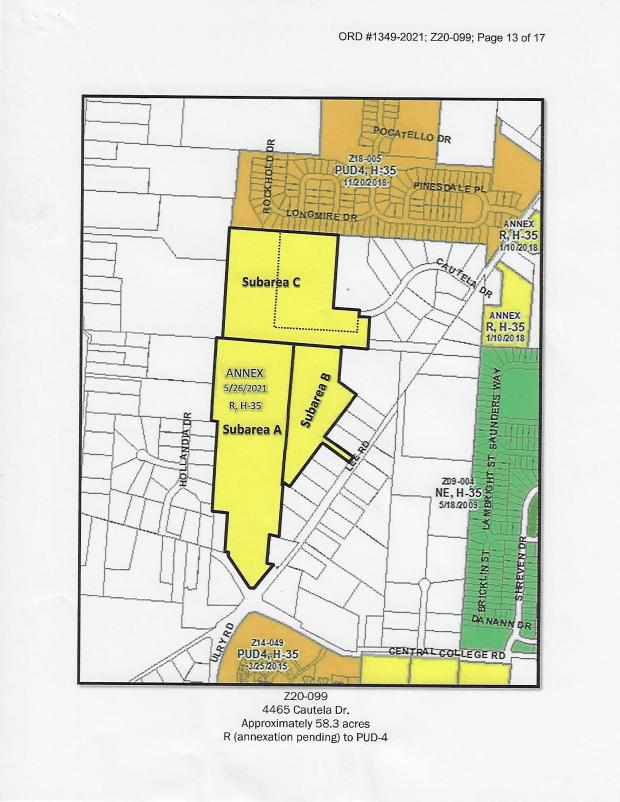Advertisement
I recently received a phone call from Andrew Nortz who is a 6½ year resident of Blendon Township and whose one-acre property abuts a new development of 27.88 acres that is currently being cleared for 156 units of one- and two-bedroom one story apartments. He asked if I would meet with him and his wife and listen to what they had to say about how they and other neighbors were bamboozled by the City of Columbus, developers and the developers’ seasoned zoning attorneys. Andrew had read about my involvement in fighting alongside of the Little Turtle neighborhood against the jaw-droppingly unethical Little Turtle Roadway project that is just around the corner from Blendon Township.
Columbus City Council unanimously approved the rezoning of the property in July of last year. Mr. Nortz gave me a tour on March 16 of the 27.88 acres that is now being developed. He said the area is home to wild turkeys, fox, deer, owls, hawks, raccoons, numerous bird species, wetlands, natural springs and vernal pools.
As an environmentalist, I was sickened to witness such a weapon of destruction by the bull hog skid steer eradicating tree after tree. Swaths of trees eliminated, along with wetlands and vernal pools that were callously run over by the skid steer. It reminded me of watching a National Geographic special of clear-cutting woodlands on a forested mountain side in Appalachia for the sole sake of profit and its ecosystem be damned.
As we approached a wetland area from about 15 yards away , you could hear the loud chorus of young froglets. As we got closer to them they began to silence. The two attached photographs above show the 27.88 acres of woodland density and what that area will look like after it is developed. The third photo below shows the subareas A,B and C in yellow. Only subarea A is owned by the developer.
The following is how this all came to be:
On July 26, 2021, Columbus City Council heard Ordinance 0349-2021 To rezone 4465 CAUTELA DR. (43081), being 58.3± acres located west of the terminus of Cautela Drive and at the northwest corner of Central College Road and Lee Road, From: R, Rural District, To: PUD-4, Planned Unit Development District (Rezoning #Z20-099).
This rezoning would allow developer Treplus Communities to clear cut roughly 25 of 27.88 acres of forest in order to spend $40 million to construct 156 one- and two-bedroom single family rental units that the developer will market for residents aged 55 and older. The units will rent between $1,900 - $2,600 a month.
The project is near the intersection of Central College Road and Lee Road. Less than one mile north of Little Turtle and very close to Hoover Reservoir Park. A total of 58.3 acres of property was annexed into Columbus from Blendon Township in October of 2020. I would guess that no less 90 percent of the 58.3 acres is forest and includes wetlands, natural springs and vernal pools.
Treplus Communities was being represented by longtime well-known and beloved City Hall zoning specialists Underhill and Hodge. Aaron Underhill and David Hodge represent big money clients such as The New Albany Company, Capital Square Ltd., Casto, MI Homes, Orange Barrell Media, Preferred Living, The Kroger Company and dozens more. The firms’ general counsel is none other than former city of Columbus Development Administrator and the go-to insider for out-of-town developers, zoning attorney Michael Shannon (known for King and High, 50 East 7th Avenue, 17 story Lane to Norwich development, Giant Eagle in Schumacher Place, Pavey Square).
The City of Columbus’s Development Commission was the first city agency to hear this zoning case on April 8, 2021 via Zoom. The City of Columbus Development Department’s staff approved the project (as usual) because they felt it accurately represented the Northland Plan’s 3.5 units per acre recommendation.
Because the area was recently annexed, it of course was not represented by an Area Commission because it wasn’t part of Columbus until recently. So, staff decided to reference the Northland Plan which, in my opinion, should have never been used as a reference considering the proposed development area is in no way in close proximity to or representative of Northland area development standards.
Because Central College and Lee Roads are the responsibility of Franklin County, improvements were going to have to be made for ingress and egress into the new development. Treplus said that they were aware of the issues and would pay for any improvements that the County Engineer required. There is also an emergency road for fire trucks to enter into the new development. The road is privately owned and does not provide the required 20 feet in width for fire trucks. This puts our firefighters and the community at risk. This road is also lined with trees on both sides. The Development Commission chair nor any commissioner addressed this issue with the developer as to how this matter was going to be resolved.
Four residents whose properties either abut or are directly impacted by the new development spoke against the proposal. One speaker pointed out that the developer had fabricated their density per acre calculations by using the entire 58.3 acres of newly annexed land. Treplus Communities only owns Subarea A which is 27.88 acres. Subareas B (8.03 acres) and C (22.43 acres) are privately owned by others. Treplus falsely claimed they were proposing 2.76 units per acre when in fact it was 5.68 units per acre. The speaker calculated that almost all of the forest (about 25 of the 27.88 acres of forest) was going to be removed to allow for the new 156 rental units.
Andrew and Malori Nortz, whose one-acre property abuts the new development, informed me that the Blendon Township zoning for this now newly-annexed area permitted only one unit per acre. The four speakers were jointly opposed to the new development primarily due to the density, traffic and sight issues (speed limit on Central College is 50 mph which is the road where the new entrance into the development will be), the emergency entrance and the devastating loss of a wooded ecosystem.
Treplus representatives countered that apartments were a “dirty word” to nearby homeowners and the developer takes pride in its product of providing housing for empty-nesters. That Treplus had “stepped up to the plate to do the right thing.” Treplus also commented that they had held a “town hall” meeting in good faith with a handful of residents about the new development.
According to Andrew and Malori Nortz, this “town hall” was nothing more than a sales pitch to the existing residents hoping that they would inform their friends or other potential tenants about the new development. The developer was not holding the town hall meeting to answer questions about the neighbors’ concerns.
The City Development Commission voted in favor of the development with a 3-2 vote while the chair abstained. (The chair’s previous comments about the development clearly indicated he was in favor of it). Two commissioners voted “no” due to environmental, density, and unresolved traffic issues. Commissioner Golden – who loves to support housing no matter where or how much – stated that, “this many units will support the growing city and anticipated housing need.” She also pretty much said the same thing when she voted in favor of Pizutti’s Giant Eagle project in Schumacher Place. These City Hall ventriloquist dolls that serve on these commissions have got to go.
On July 26, 2021, Columbus City Council heard the rezoning request. Development staff presented their same report and recommendation as they did before the Development Commission. The developers’ zoning representative Aaron Underhill gave a similar repeat overview of the project as well. After his comments it was the opposition’s turn to speak.
A dozen different property owners decided several weeks before this zoning hearing to hire an attorney to speak on their behalf. Only three speakers are permitted to speak against or in favor of an ordinance. Attorney Brandon Pauley represented the property owners. Many of his comments were typical of how residents and neighborhoods are treated by developers and their representatives in this city. Mr. Pauley stated, “Residents felt they did not have a voice in the process” and that this development is way too dense. Mature trees that were to serve as buffer between the new development and existing surrounding homes were not going to be saved. And when the buzzer rang, and his three minutes were up, he asked Chairwoman Tyson if he could have 30 seconds to conclude. And in Tyson’s typical frosty fashion she responded, “Yes, 30 seconds or less, that’s all you have.” Developers and their representatives are given an unlimited amount of time to give their presentation and to make their rebuttals of the oppositions comments.
Malori Nortz also testified and would continue to share the devastating environmental concerns and the possibility of flooding due this 27.88 acres of woodlands being removed. She also once again addressed the falsification of the developers density calculations, who claimed that the density per acre was 2.76 units, but actually 5.67 units per acre. She shared that ever since the outdated 2018 traffic study that was being used for this project, they have seen 11 new developments within 1.4 mile of the Central College and Lee Roads intersection. This has added about 1,500 new residents. No new traffic study has been done by the developer. And that while local residents were reviewing traffic concerns with the County Engineer near the intersection of Central College Road and Lee Road, an accident occurred.
Treplus representative Aaron Underhill then gave his final pitch. He indicated that 156 apartments geared towards those 55 years of age and older would not have a negative impact on the surrounding area or increase the traffic count significantly. He also still contended that their density calculations were not being misrepresented, which requires believing Treplus owned Subareas B and C. None of the City Council members questioned the density or the clear-cutting of nearly 25 acres to build 156 units on 27.88 acres that Blendon Township had previously zoned for one unit per acre. There were no questions from Council members about traffic or environmental concerns. Councilwoman Tyson frosted the Council’s cupcake by proclaiming that since City staff and the Development Commission approved of the development, that was good enough for her.
It was later discovered by local residents that rather than create a new environmentally-friendly development around 1.9 acres of wetlands, Treplus Communities was paying $98,800 of wetlands mitigation costs in order to deep excavate, fill in and compact the wetlands (and vernal pools) so they could build on top of them and create as much density as possible. Wetlands are a good thing, considering they clean the water, recharge water supplies, decrease flood risks and provide shelter and nurseries to wildlife. To put 1.9 acres in perspective, a regulation football field including the end zones is equal to 1.32 acres. Add about another half of a football field with one end zone onto that.
Based on studies from 2013, the City of Columbus’s tree canopy percentage is just 22 percent, compared to more other cities like Pittsburgh’s 37 percent and Cincinnati’s 40 percent. In September of last year, City Council announced that it was spending $1.45 million to begin the start of its urban forestry master plan with hopes that it would increase the number of trees in city neighborhoods and boost the tree canopy cover to 40 percent of the City by 2050. The City’s recreation and parks department said the City has planted or will plant a total of 4,165 trees from this past spring into this fall. Clear-cutting nearly 25 acres of woodlands and hundreds if not thousands of trees to build 156 single story apartment units, is taking one step forward and four big steps backwards towards increasing tree canopy.
I have to say that I almost regret having been informed about the devastation of this unique ecosystem. But it is a story that people need to be made aware of. A prime example of the disregard for our environment by city government and uncaring developers for the sake of profit. Just another example of how money, greed and the relationships between developers and City Council continue to steamroll local residents to push their own agenda.
Where is common decency? Where is the representation for everyday people? Where is our Lorax? Will no one speak for the trees? And I look to our Mayor and City Council-will you only speak for developers, their attorneys and lobbyists?




